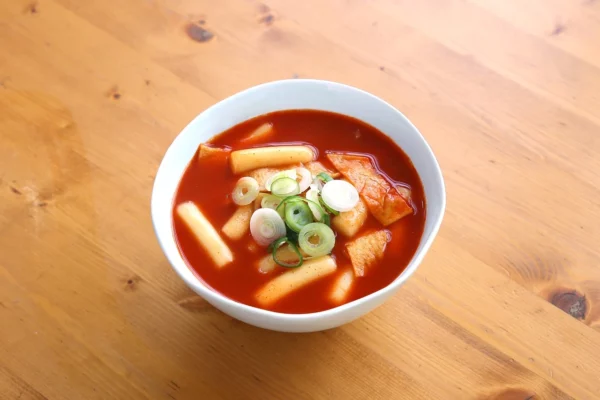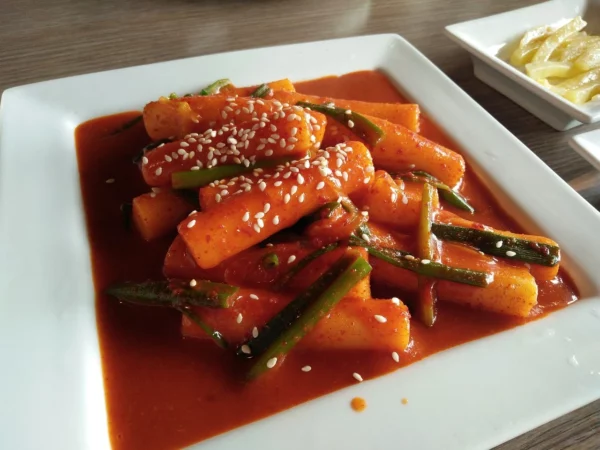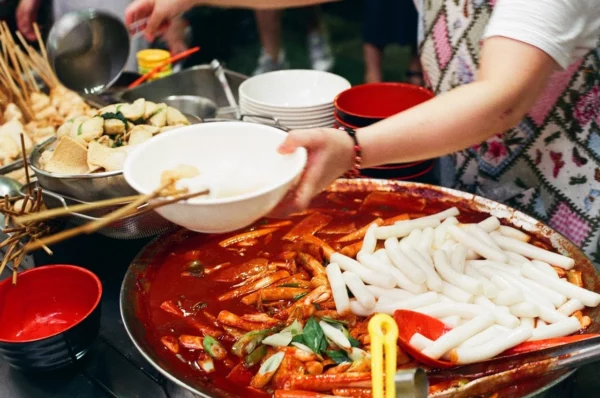Learn how to make spicy Tteokbokki rice cakes with this easy guide. Perfect for those who love bold flavors!
Mastering Spicy Tteokbokki : The Ultimate Guide
Introduction to Tteokbokki
Tteokbokki, also known as spicy stir-fried rice cakes, is a beloved Korean dish renowned for its chewy rice cakes drenched in a spicy, savory sauce. This dish is a staple of Korean street food culture, adored by people of all ages. The combination of textures and flavors in tteokbokki offers an unforgettable culinary experience that resonates with both tradition and modernity.

The Historical Roots of Tteokbokki
Originating from the royal court cuisine of the Joseon Dynasty, tteokbokki has evolved from a sophisticated, soy sauce-based dish to the spicy version that dominates Korean street food today. Initially known as “gungjung tteokbokki,” this dish was enjoyed by the Korean nobility. Over time, the introduction of gochujang (Korean chili paste) transformed it into the fiery delight that captivates taste buds around the world.
Essential Ingredients for Authentic Tteokbokki
Core Components
- Tteok (Rice Cakes): The foundation of the dish, providing a chewy and satisfying texture.
- Gochujang (Korean Chili Paste): The primary source of heat and flavor.
- Eomuk (Fish Cakes): Adds a savory depth and protein.
- Gochugaru (Korean Chili Flakes): Enhances the spiciness and adds texture.
- Soy Sauce: Introduces a salty, umami component.
- Sugar: Balances the heat with a touch of sweetness.
- Garlic: Freshly minced for robust flavor.
- Green Onions: For garnish and additional flavor.
Optional Additions
- Boiled Eggs: Adds richness and protein.
- Cabbage: For added crunch and sweetness.
- Carrots: Provides color and a slight sweetness.
- Onions: Enhances the overall flavor profile.

Equipment Needed for Tteokbokki Preparation
- Large Pot: For boiling the rice cakes and simmering the sauce.
- Strainer: To drain the rice cakes.
- Mixing Bowls: For preparing the sauce and ingredients.
- Cooking Utensils: Such as a spatula and ladle for stirring and serving.
Step-by-Step Preparation of Tteokbokki
Preparing the Ingredients
- Soak the Rice Cakes: If using frozen or hardened rice cakes, soak them in warm water for 30 minutes until they soften.
- Slice the Fish Cakes: Cut the fish cakes into bite-sized pieces.
- Chop the Vegetables: Prepare green onions, cabbage, carrots, and any other vegetables you plan to use.
Making the Sauce
- Combine the Sauces: In a mixing bowl, combine gochujang, gochugaru, soy sauce, sugar, and minced garlic.
- Mix Thoroughly: Stir until the ingredients are well-blended and the sauce is smooth.
Cooking Techniques for Perfect Tteokbokki
Detailed Cooking Process
- Boil the Rice Cakes: In a large pot, bring water to a boil and cook the rice cakes until they float to the surface. Drain and set aside.
- Simmer the Sauce: In the same pot, add the prepared sauce and a cup of water. Bring to a simmer.
- Add the Ingredients: Add the rice cakes, fish cakes, and vegetables to the pot. Stir to coat everything in the sauce.
- Cook Thoroughly: Simmer for 10-15 minutes, stirring occasionally, until the sauce thickens and the ingredients are well-cooked.
- Finish with Green Onions: Add chopped green onions during the last few minutes of cooking for added flavor and color.
Common Mistakes to Avoid
- Overcooking the Rice Cakes: This can make them too soft and lose their chewy texture.
- Not Adjusting the Spice Level: Start with a smaller amount of gochujang and gochugaru, then adjust to taste.
- Using Low-Quality Ingredients: Fresh, high-quality ingredients make a significant difference in flavor.
Tips for Perfect Tteokbokki
- Consistency of Sauce: Ensure the sauce is thick enough to coat the rice cakes but not too thick that it becomes sticky.
- Balancing Flavors: Adjust the sweetness, spiciness, and saltiness to your preference for a harmonious taste.
- Serving Hot: Tteokbokki is best enjoyed hot, straight from the pot.
Variations of Tteokbokki
Cheese Tteokbokki
Adding cheese to tteokbokki creates a creamy, indulgent version of the dish. Mozzarella is commonly used for its melt-in-your-mouth texture.
Seafood Tteokbokki
Incorporate shrimp, squid, or mussels for a seafood twist that adds a delightful briny flavor to the dish.
Rose Tteokbokki
A fusion version combining cream and tomato sauce with the traditional gochujang sauce, resulting in a milder, creamy dish.
Bulgogi Tteokbokki

Serving Suggestions
Traditional Serving Style
Serve tteokbokki in a large communal pot placed at the center of the table, allowing everyone to dig in together. Accompany with side dishes like kimchi and pickled radishes.
Individual Portions
Serve in individual bowls, garnished with sesame seeds and additional green onions. Pair with a bowl of rice or noodle soup for a complete meal.
Pairing Tteokbokki with Other Dishes
- Kimbap: Korean rice rolls that complement the spiciness of tteokbokki.
- Japchae: Stir-fried glass noodles that add a different texture and flavor profile.
- Korean Fried Chicken: For a hearty, satisfying meal combination.
Health Benefits and Nutritional Information
Nutritional Profile
Tteokbokki is rich in carbohydrates from the rice cakes, proteins from fish cakes and optional eggs, and vitamins from various vegetables. However, it is also high in sodium and should be consumed in moderation.
Health Benefits
- Energy Boosting: The carbohydrates provide a quick source of energy.
- Rich in Antioxidants: Ingredients like garlic and green onions offer antioxidant properties.
- Versatile and Customizable: Can be adapted to include more vegetables or lean proteins for a healthier option.
Storing and Reheating Tteokbokki
Proper Storage
Store leftover tteokbokki in an airtight container in the refrigerator for up to 2-3 days.
Reheating Tips
Reheat in a pot on the stove over low heat, adding a splash of water to rehydrate the sauce and prevent it from becoming too thick.
Frequently Asked Questions (FAQs)
What is Tteokbokki made of?
Tteokbokki is made of rice cakes (tteok), fish cakes (eomuk), gochujang (Korean chili paste), gochugaru (Korean chili flakes), soy sauce, sugar, garlic, and green onions.
Can Tteokbokki be made less spicy?
Yes, you can reduce the amount of gochujang and gochugaru or substitute with a mild chili sauce to make a less spicy version.
Is Tteokbokki gluten-free?
Traditional tteokbokki is not gluten-free due to the soy sauce and fish cakes. However, you can use gluten-free soy sauce and check fish cakes for gluten-free certification.
Can I freeze Tteokbokki?
It is not recommended to freeze tteokbokki as the texture of the rice cakes may change. However, you can freeze the rice cakes separately and prepare the dish fresh.
Conclusion
Making spicy tteokbokki at home allows you to enjoy this beloved Korean dish with a personal touch. Whether you stick to the traditional recipe or experiment with variations, the key is to balance the flavors and textures for a satisfying meal. Gather your ingredients, follow the steps, and enjoy the rich, spicy goodness of homemade tteokbokki. This guide equips you with everything you need to master the art of tteokbokki and share this delightful dish with friends and family.
By following this comprehensive guide, you’ll be able to create delicious and authentic spicy tteokbokki that rivals even the best street vendors in Korea. Enjoy the process of making and sharing this dish, and embrace the warmth and comfort it brings to your table.
A[Rice Cakes] --> B[Boil]
A --> C[Sauce Preparation]
A --> D[Add Vegetables]
A --> E[Add Fish Cakes]
A --> F[Simmer]
A --> G[Finish with Green Onions]
👇👇 한국어 / Koren 👇👇
안녕하세요, 떡볶이 마니아 여러분! 오늘은 우리 모두가 사랑하는 한국의 대표 길거리 음식, 떡볶이에 대해 깊이 파헤쳐 볼게요. 함께 떡볶이의 세계로 빠져볼까요?
떡볶이, 그 매력적인 역사
여러분, 떡볶이가 궁중 요리에서 시작됐다는 걸 아셨나요? 정말 놀랍죠? 처음에는 간장 맛이었다가 지금의 매콤한 맛으로 진화했어요. 한국 음식의 역사가 참 재미있지 않나요?
떡볶이의 필수 재료들
자, 이제 본격적으로 떡볶이 만들기에 도전해볼까요? 필요한 재료는 그리 많지 않아요:
– 쫄깃한 떡
– 매콤한 고추장
– 담백한 어묵
– 그리고 몇 가지 비밀 양념들!
여기에 채소를 추가하거나 치즈를 얹어 나만의 특별한 떡볶이를 만들어보세요.
떡볶이 소스의 비밀
떡볶이의 영혼은 바로 소스에 있어요. 고추장, 고춧가루, 간장, 설탕, 마늘을 절묘하게 조화시켜야 해요. 이 비율을 잘 맞추면 여러분도 떡볶이 달인이 될 수 있답니다!
조리 시 주의사항
떡볶이를 만들 때 가장 조심해야 할 점은 뭘까요? 바로 떡을 너무 오래 끓이지 않는 거예요. 쫄깃한 식감을 지키는 게 중요하거든요. 그리고 처음에는 매운 맛을 조금만 넣고 시작하세요. 나중에 입맛에 맞게 조절할 수 있으니까요.
떡볶이, 함께 나눠 먹어요
떡볶이의 진정한 맛은 나눠 먹을 때 나타나요. 큰 냄비에 담아 테이블 가운데 놓고, 가족이나 친구들과 함께 즐겨보세요. 이런 소소한 행복이 우리 일상을 풍요롭게 만들어주죠.
건강한 떡볶이 즐기기
건강을 걱정하시는 분들도 계실 텐데요. 떡볶이도 건강하게 즐길 수 있어요. 채소를 듬뿍 넣고, 나트륨 섭취를 조금 줄이면 돼요. 맛있게 먹으면서 건강도 챙기는 거죠!
나만의 떡볶이 레시피를 만들어봐요
이제 떡볶이 만들기에 자신이 생기셨나요? 한번 도전해보세요! 실패해도 괜찮아요. 요리는 실패할수록 늘어간답니다. 여러분만의 특별한 떡볶이 레시피를 만들어보는 것도 좋겠죠?
마치며
떡볶이를 만들 때 가장 중요한 건 즐거운 마음이에요. 맛있는 음식을 만들고 나누는 과정 자체가 행복이니까요. 여러분의 주방에서 떡볶이의 맛있는 향이 가득하길 바랄게요. 다음에 또 다른 맛있는 레시피로 찾아올게요. 감사합니다!